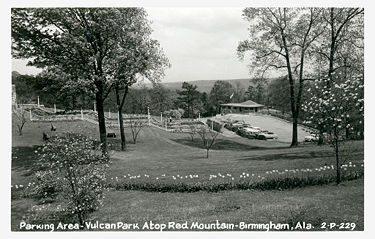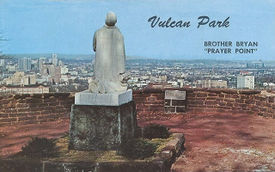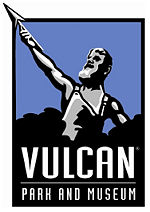Vulcan Park
Vulcan Park is a 10-acre Birmingham city park developed in the late 1930s as a setting to display the statue of Vulcan on Red Mountain, overlooking the city. The statue of Vulcan, along with the tower and the park grounds, underwent a significant program of restoration in 1999. Although owned by the city, since its renovation the park has been managed and operated by the non-profit Vulcan Park Foundation.
Creation
After his return from the 1904 St Louis World's Fair, Vulcan was displayed at the Alabama State Fairgrounds. His uplifted arm had been damaged in transit and was re-cast and attached at the wrong angle, without a spear. He was used for advertising and re-painted several times.
As early as the late 1920s community leaders were looking for a more suitable setting for the iconic statue. A committee formed by the Birmingham City Commission, Birmingham Park and Recreation Board and the Birmingham Kiwanis Club secured assistance from the Federal Works Progress Administration to develop a park alongside Montgomery Highway on Red Mountain.
Warren Knight & Davis collaborated with parks superintendent R. S. Marshall on a design for the park layout and the 126-foot tall sandstone pedestal for the statue. A pair of broad stone stairways followed the hillside down to a parking area, with a cascade of water flowing between them. A visitor's center and office was constructed adjacent to the parking area. The grounds were planted with grass and flowers and a paved overlook, called "Prayer Point" formed the north edge of the park, with a view into Jones Valley.
The park was dedicated with ten-day "Vulcan Dedication Celebration" from May 7 to May 17, 1939. The festival included a pageant with a cast of 1,200 on four stages accompanied by a 12-piece orchestra and "kaleidoscopic" lighting effects. The statue and its park setting remained the city's most recognizable landmark and tourist destination over the ensuing decades.
Later developments
In November 1944 Mrs Guy Orr and Mrs W. A. Norton of the William Speer Chapter of the Daughters of the American Revolution organized a project to plant 200 pink dogwoods along the road from Old Montgomery Highway to the park's parking lot. The Alabama Federation of Women's Clubs and other groups contributed to the $200-500 project, which was anticipated to "compare with the famous cherry blossom trees in Washington." City horticulturist William Avant was assigned to maintain the plantings.
In 1956 and again in 1965 there was discussion of opening the former Valley View Mine near Vulcan Park to visitors. Architect Fred Hallmark, chair of the Vulcan Park Improvement Commission, estimated that it could be made safe and accessible for tours, exhibits and programs at a cost of around $75,000. Hallmark also discussed the possibility of constructing an 18,000-seat amphitheater on land previously offered to the city on the Homewood side of the park.
In November 1966 the Women's Committee of 100 arranged for the relocation of Georges Bridges' statue of beloved minister Brother Bryan from Five Points South to an overlook at Vulcan Park, which was dubbed Prayer Point. The kneeling figure was oriented to face the 3rd Presbyterian Church he had led. The statue returned to Southside following a petition drive in 1983.
1972 renovation
In anticipation of Birmingham's 1971 centennial the city funded a $1 million overhaul of Vulcan Park. The first phases of the project were paid for out of the city's general fund, to be rapaid when bonds were issued in 1970.
Beginning in 1969 Architect Marion Bradford of Elliott & Bradford designed a major upgrade to park facilities, including a visitors' center with a gift shop and snack area connected to the statue's pedestal by a covered walkway. The pedestal itself was clad in white Alabama marble and an enclosed observation deck was built around its top, connected to the ground by passenger elevator. The base of the pedestal was wrapped with an exhibit gallery. Dunn Construction served as general contractor.
Preliminary plans for beautification of the grounds were commissioned from Chattanooga landscape architect Colman S. Hocham. New ramped walkways were laid out, lined with marble-clad walls and flanked by fountains and flower beds. The renovated park re-opened in 1972.
1980s conference center proposal
In late 1984, partly inspired by City Council members' experience at Maxwell's Plum in Ghirardelli Square during a council trip to San Francisco, California, Mayor Richard Arrington commissioned Moss & Associates Architects to prepare a preliminary design for a 300-seat fine restaurant and conference center at Vulcan Park which would take advantage of the views from Red Mountain on the northeast portion of the park.
Charles Moss's 3-story design, projected to cost between $3 million and $5 million, included a banquet hall for 400 diners along with a lounge and conference rooms, all featuring large plate glass windows. A central atrium would also have a glass skylight to show the Vulcan statue. He presented his design to the Council's Park and Recreation Committee, chaired by Nina Miglionico, in August 1985 and they voted unanimously to forward it to the full council.
If construction were approved, the city would finance construction through its $44 million bond issue which had been approved in 1984, and would solicit proposals from private operators to generate franchise revenues to offset the expense. It was not expected to be profitable, but to stand alongside the Birmingham Zoo, Birmingham Museum of Art, and Birmingham Botanical Gardens as amenities for residents and as attractions for visitors. Its opening was anticipated to coincide with the Birmingham Race Course. The conference center would host meetings, events and weddings catered by the restaurant. Valet parking in a 300-space lot off of 20th Street South would be available.
Though a majority of council members had been supportive of the idea, it met an unwelcome reception and from restaurateurs who would be competing with a public project. The council ultimately voted to give the idea more study before approving funds.
Miglionico, in her last months in office, worked with Ann Adams of the Birmingham Department of Community Development to convene a meeting of community leaders in October to discuss options for upgrading the park. Some of the ideas discussed included expanding the park along the north slope of Red Mountain to exhibit the old Lone Pine Mine entrance and to make use of the former Birmingham Mineral Railroad bed for recreation. Alabama Hiking Association president Mike Leonard spoke up for the latter notion. Tom Cosby of the Birmingham Area Chamber of Commerce pitched the idea of constructing a 1,000 seat amphitheater at the statue's feet with the city as its backdrop. He hoped the scarcity of space for parking could be offset by special service from MAX buses during events.
2004 restoration
In 1990 an engineering study concluded that the physical condition of the Vulcan statue had deteriorated to a dangerous level. By the late 1990s the park had been closed. Vulcan was removed for restoration in 1999 and the Vulcan Park Foundation was created to oversee a $14 million restoration of the statue and the park, complete with a new interpretive museum and event center. Brice Building Company performed the work, designed by HKW Architects. Plans included restoring the original tower and stone stairways (without the water cascade). A new elevator was constructed to preserve access for disabled visitors and the Vulcan trail walking trail was constructed along the former Birmingham Mineral Railroad bed.
The project was funded in part by a grant from the U.S. Department of the Interior. The appropriation, secured by Senator Richard Shelby in 2001, was criticized by Senator John McCain of Arizona who introduced an amendment to block the measure. The full Senate voted 87-12 to override his amendment. The project was recognized with an Honor Award from the National Trust for Historic Preservation in 2006.
Current status
The Vulcan Park Foundation continues to operate the park and visitors center. Access to the museum and observation deck requires the purchase of a ticket. The visitor's center is equipped to host meetings, receptions and other events. The park also schedules frequent public concerts and special events, including Vulcan's birthday party. The foundation uses a plush Vulcan mascot in its educational outreach and marketing efforts. In 2009 it became one of the first institutions to install Ideum MT2 50-inch multi-touch interactive tabletop displays. The park's custom-designed interactive program combines Yahoo! maps and geotagged Flickr content. [1]
In Spring 2010 the City Council approved $30,000 in extra funding to pay for an exterior sealant to prevent water from coming through the pedestal's stone walls. The work coincided with a scheduled re-painting of the statue itself. In 2015 the Park Foundation proposed a $500,000 renovation project to triple the size of the gift shop and add a permanent ticket booth at the park entrance.
In November 2016 the Kiwanis Club of Birmingham announced a commitment of $4 million to help fund a complete renovation of the north-facing entrance to the park, adding a paved, multi-use plaza called "Kiwanis Centennial Park". Additionally, the group plans to support the extension of Vulcan Trail to Green Springs Highway and to commission a multi-colored LED light installation to allow the statue to be bathed in varying colors.
In March 2018, the Kiwanis Centennial Park opened for public use. A new fountain is the centerpiece of park and a series of stone steps lead visitors to the Vulcan Trail and up to Vulcan Park and the Museum. The plaza can be used as an event space with a spectacular view of the city.
Kiwanis Vulcan Trail, will serve as the future hub for the planned 750 miles of Birmingham's Red Rock Trail System.
Vulcan Park is also the site of the city's annual Thunder on the Mountain Independence Day fireworks show.
References
- "Visitors to Vulcan Next Year Will See Pink Dogwood Trail." (August 1944) The Birmingham News
- Bryant, Ted (April 8, 1965) "Opening Of Old Mine To Public Discussed." Birmingham Post-Herald
- "Architect hired—; Vulcan park beauty plans to be drawn." (December 1969) The Birmingham News
- Lucke, Jamie (August 9, 1985) "carries torch for eating atop mountain" Birmingham Post-Herald, p. C2
- Chapman, Michaelle (September 11, 1985) "Council drops restaurant plans." Birmingham Post-Herald, p. D1
- Chapman, Michaelle (October 3, 1985) "Leaders say Vulcan needs dressing up." Birmingham Post-Herald, p. C4
- "Vulcan statue" (March 20, 2006) Wikipedia - accessed March 20, 2006
- Morris, Philip A. (1995) Vulcan and His Times. Birmingham: Birmingham Historical Society.
- Wright, Barnett (March 22, 2010) "Birmingham's Vulcan to get a new paint job." The Birmingham News
- Rebman, Stephanie (November 15, 2016) "Kiwanis Club plans $4M upgrade for Vulcan Park." Birmingham Business Journal
- Prickett, Sam (November 30, 2016) "Vulcan™: Deconstructing the complex — and often misunderstood — trademark on the most famous statue in Birmingham." Weld for Birmingham
- Songer, Joe (March 22, 2018) "The new Kiwanis Centennial Park and Vulcan Trail opens" The Birmingham News
External links
- Vulcan Park Foundation
- Vulcan Statue & Park records in the Historic American Engineering Record at the Library of Congress





